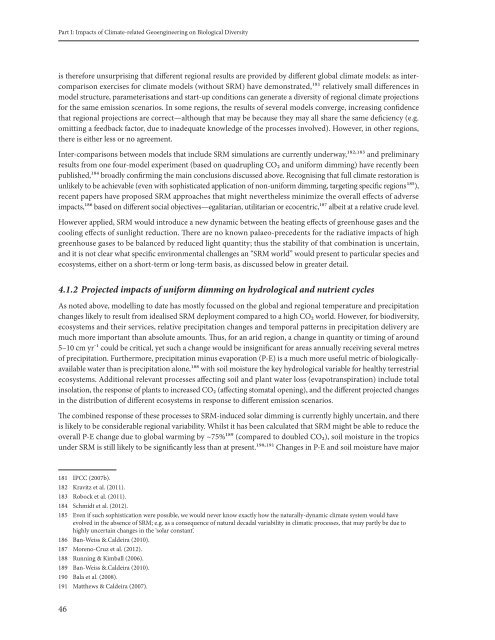cbd-ts-66-en
cbd-ts-66-en
cbd-ts-66-en
You also want an ePaper? Increase the reach of your titles
YUMPU automatically turns print PDFs into web optimized ePapers that Google loves.
Part I: Impac<strong>ts</strong> of Climate-related Geo<strong>en</strong>gineering on Biological Diversity<br />
is therefore unsurprising that differ<strong>en</strong>t regional resul<strong>ts</strong> are provided by differ<strong>en</strong>t global climate models: as intercomparison<br />
exercises for climate models (without SRM) have demonstrated,181 relatively small differ<strong>en</strong>ces in<br />
model structure, parameterisations and start-up conditions can g<strong>en</strong>erate a diversity of regional climate projections<br />
for the same emission sc<strong>en</strong>arios. In some regions, the resul<strong>ts</strong> of several models converge, increasing confid<strong>en</strong>ce<br />
that regional projections are correct—although that may be because they may all share the same defici<strong>en</strong>cy (e.g.<br />
omitting a feedback factor, due to inadequate knowledge of the processes involved). However, in other regions,<br />
there is either less or no agreem<strong>en</strong>t.<br />
Inter-comparisons betwe<strong>en</strong> models that include SRM simulations are curr<strong>en</strong>tly underway,182, 183 and preliminary<br />
resul<strong>ts</strong> from one four-model experim<strong>en</strong>t (based on quadrupling CO2 and uniform dimming) have rec<strong>en</strong>tly be<strong>en</strong><br />
published,184 broadly confirming the main conclusions discussed above. Recognising that full climate restoration is<br />
unlikely to be achievable (ev<strong>en</strong> with sophisticated application of non-uniform dimming, targeting specific regions185),<br />
rec<strong>en</strong>t papers have proposed SRM approaches that might nevertheless minimize the overall effec<strong>ts</strong> of adverse<br />
impac<strong>ts</strong>,186 based on differ<strong>en</strong>t social objectives—egalitarian, utilitarian or ecoc<strong>en</strong>tric,187 albeit at a relative crude level.<br />
However applied, SRM would introduce a new dynamic betwe<strong>en</strong> the heating effec<strong>ts</strong> of gre<strong>en</strong>house gases and the<br />
cooling effec<strong>ts</strong> of sunlight reduction. There are no known palaeo-preced<strong>en</strong><strong>ts</strong> for the radiative impac<strong>ts</strong> of high<br />
gre<strong>en</strong>house gases to be balanced by reduced light quantity; thus the stability of that combination is uncertain,<br />
and it is not clear what specific <strong>en</strong>vironm<strong>en</strong>tal chall<strong>en</strong>ges an “SRM world” would pres<strong>en</strong>t to particular species and<br />
ecosystems, either on a short-term or long-term basis, as discussed below in greater detail.<br />
4.1.2 Projected impac<strong>ts</strong> of uniform dimming on hydrological and nutri<strong>en</strong>t cycles<br />
As noted above, modelling to date has mostly focussed on the global and regional temperature and precipitation<br />
changes likely to result from idealised SRM deploym<strong>en</strong>t compared to a high CO2 world. However, for biodiversity,<br />
ecosystems and their services, relative precipitation changes and temporal patterns in precipitation delivery are<br />
much more important than absolute amoun<strong>ts</strong>. Thus, for an arid region, a change in quantity or timing of around<br />
5–10 cm yr-1 could be critical, yet such a change would be insignificant for areas annually receiving several metres<br />
of precipitation. Furthermore, precipitation minus evaporation (P-E) is a much more useful metric of biologicallyavailable<br />
water than is precipitation alone,188 with soil moisture the key hydrological variable for healthy terrestrial<br />
ecosystems. Additional relevant processes affecting soil and plant water loss (evapotranspiration) include total<br />
insolation, the response of plan<strong>ts</strong> to increased CO2 (affecting stomatal op<strong>en</strong>ing), and the differ<strong>en</strong>t projected changes<br />
in the distribution of differ<strong>en</strong>t ecosystems in response to differ<strong>en</strong>t emission sc<strong>en</strong>arios.<br />
The combined response of these processes to SRM-induced solar dimming is curr<strong>en</strong>tly highly uncertain, and there<br />
is likely to be considerable regional variability. Whilst it has be<strong>en</strong> calculated that SRM might be able to reduce the<br />
overall P-E change due to global warming by ~75%189 (compared to doubled CO2), soil moisture in the tropics<br />
under SRM is still likely to be significantly less than at pres<strong>en</strong>t.190, 191 Changes in P-E and soil moisture have major<br />
181 IPCC (2007b).<br />
182 Kravitz et al. (2011).<br />
183 Robock et al. (2011).<br />
184 Schmidt et al. (2012).<br />
185 Ev<strong>en</strong> if such sophistication were possible, we would never know exactly how the naturally-dynamic climate system would have<br />
evolved in the abs<strong>en</strong>ce of SRM; e.g. as a consequ<strong>en</strong>ce of natural decadal variability in climatic processes, that may partly be due to<br />
highly uncertain changes in the ‘solar constant’.<br />
186 Ban-Weiss &.Caldeira (2010).<br />
187 Mor<strong>en</strong>o-Cruz et al. (2012).<br />
188 Running & Kimball (2006).<br />
189 Ban-Weiss &.Caldeira (2010).<br />
190 Bala et al. (2008).<br />
191 Matthews & Caldeira (2007).<br />
46


